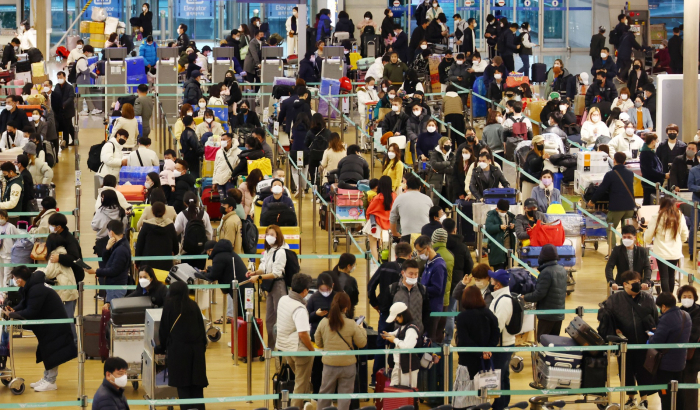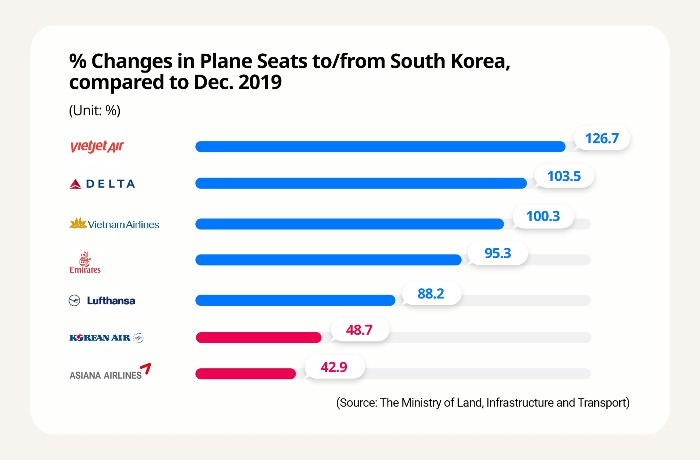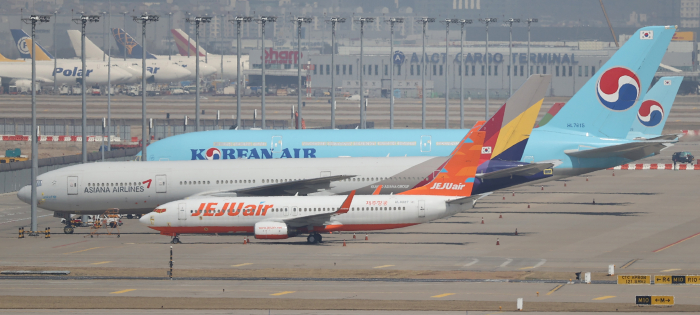Airlines
Foreign airlines fill hole left by Korean carriers
Airlines worldwide are expected to see first profit since 2019
By Jan 30, 2023 (Gmt+09:00)
2
Min read
Most Read
LG Chem to sell water filter business to Glenwood PE for $692 million


KT&G eyes overseas M&A after rejecting activist fund's offer


Mirae Asset to be named Korea Post’s core real estate fund operator


StockX in merger talks with Naver’s online reseller Kream


Meritz backs half of ex-manager’s $210 mn hedge fund



Foreign carriers such as Delta Air Lines and Vietnam’s VietJet Air are rapidly increasing flights to and from South Korea, filling the hole left after South Korean carriers were relatively late in catching up due to pandemic requirements.
In December 2022, the number of passenger seats to and from South Korea’s Incheon International Airport supplied by 67 foreign flights leapt to 823,760. That is equivalent to 51% of the pre-pandemic level, or 1.6 million seats available in December 2019.
The seats for international flights included those from Chinese and Japanese airlines. Both countries recently reopened their borders, later than other countries.
Excluding Chinese and Japanese carriers, foreign flights’ passenger capacity for arrivals and departures in Incheon recovered to 73% of pre-pandemic levels.
Emirates, one of two flag carriers of the United Arab Emirates and Germany’s Lufthansa boosted the number of available seats to and from Incheon to 95.3% and 88.2%, respectively.
Delta and two Vietnamese carriers -– Vietnam Airlines and VietJet Air -- raised international seats to and from Incheon to beyond pre-pandemic levels.

By comparison, eight South Korean carriers increased their passenger seats on international routes to a combined 1.62 million last month. That was a 52.9% increase from that of December 2019, just before COVID-19 struck, according to the transport ministry.
Compared to December 2021, or at the height of the pandemic, the number of their international passenger seats jumped sixfold.
Two full-service carriers Korean Air Co. and Asiana Airlines Inc. accounted for 92%.
SOUTHEASTERN AIRLINES
Particularly, airlines in Southeast Asia such as VietJet Air and Vietnam Airlines are aggressively penetrating South Korea’s aviation market, as their countries reopened their borders ahead of other regions.
European carriers such as Lufthansa and Finnair target travelers to and from Incheon by offering transfer routes.
The number of available seats supplied by airlines is a leading indicator of air travel demand.
Bolstered by increased flights, airlines worldwide are forecast to turn to a net profit of $4.7 billion this year in aggregate, for the first time since 2019.
According to the International Air Transport Association, air travel demand is projected to rebound to 85.5% of the pre-pandemic level, or compared to that of 2019.

AIRLINES IN KOREA
By contrast, the passenger capacity of Korean Air and Asiana Airlines is unlikely to reach an average of 50% pre-pandemic levels until the first quarter of this year, weighed by toughened COVID-19 testing requirements on Chinese arrivals.
But Korean Air will increase flights to the Americas, Europe and Southeast Asia from the last week of March, bringing its international flights to about 60% of pre-pandemic levels. To accommodate more travelers, it plans to fly large airplanes.
Write to Kyung-Min Kang at Kkm1026@hankyung.com
Yeonhee Kim edited this article.
More to Read
-
 AirlinesAir Busan to offer 4 daily flights on Busan-Osaka route
AirlinesAir Busan to offer 4 daily flights on Busan-Osaka routeJan 26, 2023 (Gmt+09:00)
1 Min read -
 AirlinesKorean Air to resume flight services on four European routes
AirlinesKorean Air to resume flight services on four European routesJan 20, 2023 (Gmt+09:00)
1 Min read -

-
 AirlinesForeign airlines gnaw at Korean LCCs on international flight routes
AirlinesForeign airlines gnaw at Korean LCCs on international flight routesDec 20, 2022 (Gmt+09:00)
3 Min read -
 AirlinesAir Busan to resume Busan-Vientiane flights after 3-year hiatus
AirlinesAir Busan to resume Busan-Vientiane flights after 3-year hiatusDec 19, 2022 (Gmt+09:00)
1 Min read -
 AirlinesS.Korean Airlines increase flights in anticipation of travel boom
AirlinesS.Korean Airlines increase flights in anticipation of travel boomDec 16, 2022 (Gmt+09:00)
1 Min read -
 AirlinesGlobal airlines raise flights to pre-COVID levels on border reopening
AirlinesGlobal airlines raise flights to pre-COVID levels on border reopeningMar 14, 2022 (Gmt+09:00)
4 Min read
Comment 0
LOG IN


